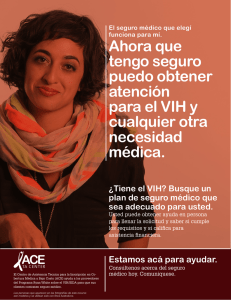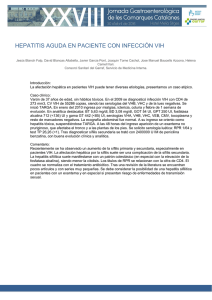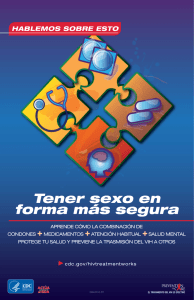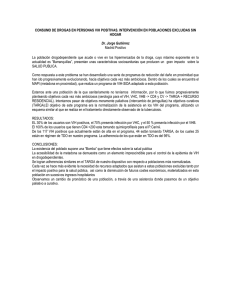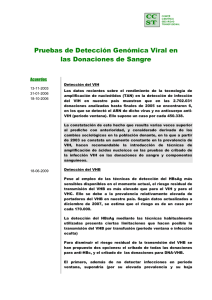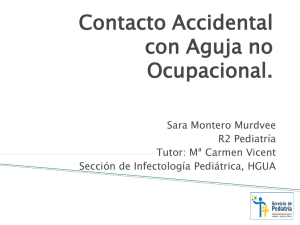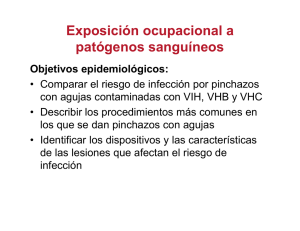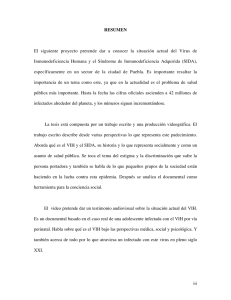coinfección vhb/vih
Anuncio
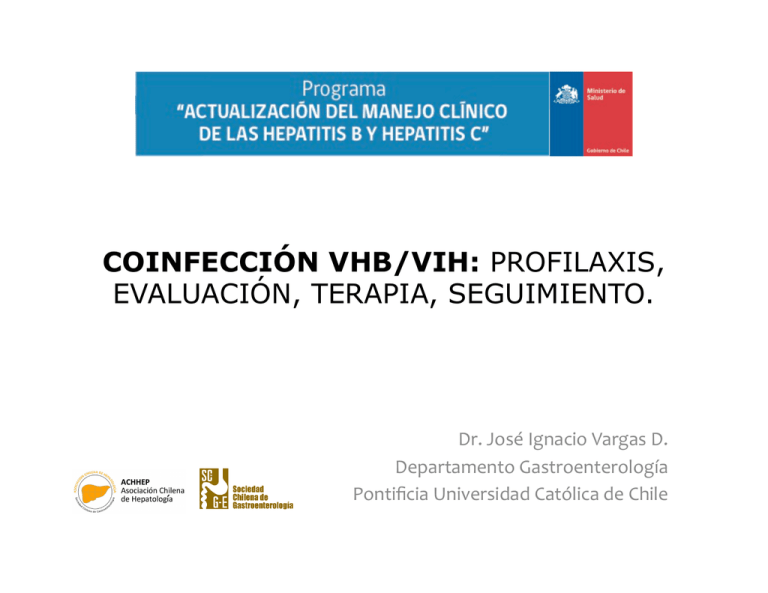
COINFECCIÓN VHB/VIH: PROFILAXIS, EVALUACIÓN, TERAPIA, SEGUIMIENTO. Dr.JoséIgnacioVargasD. DepartamentoGastroenterología PontificiaUniversidadCatólicadeChile II SIMPOSIO DE ACCESO A NUEVAS TERAPIAS PARA HEPATITIS C Fecha: Miércoles 17 de junio de 2015 (17:00 – 20:00 h) Lugar: Sede Colegio Médico (Esmeralda 678, Santiago) Organización: Asociación Chilena de Hepatología (ACHHEP) COINFECCIÓN VHB/VIH: PROFILAXIS, EVALUACIÓN, TERAPIA, SEGUIMIENTO. • HojadeRuta – Epidemiología – HistoriaNatural – Diagnóstico – Prevención – Tratamiento – Seguimiento EPIDEMIOLOGÍA PREVALENCIA VHB EN POBLACIÓN VIH • La coinfección VHB con VIH es relativamente común: 5-20%. – Comparten modos de transmisión – Varía según zonas de endemicidad. – Factores deHEPATOLOGY, riesgo conocidos países occidentales. Vol. 49, No. 5, en Suppl., 2009 23% developed chronic hepatitis B com HIV-uninfected men (P ! 0.03). Of no T cell counts were lower in the HIV-in veloped chronic hepatitis B compared men who did not become chronically tion also decreases the rate of hepatitis B clearance up to five-fold and increases t lication as manifested by higher HBV D HIV-infected persons who acquire pr hepatitis B surface antigen (anti-HBs) r of anti-HBs and subsequent reactivati seroconversion).15,16 Fig. B1.andPrevalence of chronic hepatitis varies by Hepatology. geography and Thio CL. Hepatitis human immunodeficiency virus B coinfection. 2009;49(5 Suppl):S138-45. Of all these negative consequences, t route of infection. The prevalence of chronic hepatitis B in areas of low endemicity, such as Western Europe and the United States, averages that HIV accelerates the progression o 5%-7% of the HIV-infected population with the percentage varying by the disease. Cirrhosis is more common in route of infection. In general, the prevalence in high-endemicity countries EPIDEMIOLOGÍA MORTALIDAD POR VHB EN POBLACIÓN VIH The n e w e ng l a n d j o u r na l m e dic i n HC V I 35 30 30 #0&/ 25 20 14 15 10 9 8 ."',2/!1). '/#/# ,+ +!#./ 5 0 '2#. '/#/# >500 +0-#.** of 350–499 200–349 Koziel et al. N Engl J Med 2007;356:1445-54. The natural history of in patients with HIV progression to cirrho ease, hepatocellular c mune restoration wit therapy decreases the ease.27 In addition to is associated with ch chiatric function,28,29 and an increased prev all of which potentia HIV infection. There a vary geographically; North America.32 The effect of HCV of HIV disease is les impaired immune re emained obscure. The paucity of knowldge of this condition is partly due to its HISTORIA NATURAL mild disease in the majorEFECTOS VIHmanifestations SOBRE VHB y of patients. A better-described aspect of ccult infection is HBV transmissibility in impaired cellul EFECTOSSOBREVHB gastrointestinal • Mayorinfeccióncrónica HIV Peptide Liver ligand (e.g. yrcludex BTM) HBV pre-S1 Hepatic effects • Mayoresnivelesviremia In vitro exposur Conjugated Drugs (e.g. • Mayorreactivación increases HCV r Gastrointestinal bile acids ciclosporin, • MáscirrosisyHCC tract with increased T ezetimibe) Na+ gene expression. TGF-β1 antibodi sure on HCV re in a positive feed This increased r Bica I et al. Clinical Infectious Diseases 2001. Thio CL et al. The Lancet. 2002. Mucosal CD4+ ependent. By remained obscure. The edge of this condition d substrates, HISTORIA NATURAL mild disease manifestat nd vice versa. EFECTOS VHB SOBRE VIH REVIEWS ng could open ity of patients. A betteroccult infection is HBV r development EFECTOSSOBREVIH • InicioprecozdeTARV HIV BV infection. • MásefectosadversosaTARV le acid deriva– Síndromedereconstitución Peptide HBV C inmune Immune system Liver Gas o NTCP could ligand (e.g. – Hepatotoxicidad TM Myrcludex B ) • MenorrespuestaaTARV d hepatocytes, CD4 cell pre-S1 step forward. ed drugs (that M CD4 T cell + Bica I et al. Clinical Infectious Diseases 2001. Thio CL et al. The Lancet. 2002. + EPIDEMIOLOGÍA GENOTIPO VHB EN POBLACIÓN VIH F A, C, B, D, G F, H G A, D A,D E F B, C B, C A VIH-VHB:genotipoF. Fung, Lok. Hepatology Vol. 40, No. 4, 2004 Venegas M et al. Arch Virol (2008) 153:2129–2132. Vargas JI, Fuster F et al. Congreso Chileno Gastroenterología 2014. TL 44. DIAGNÓSTICO PREVALENCIA COINFECCIÓN VHB-VIH EN CHILE Año HBsAg Anti-HBc Anti-HBs DNAVHB Perez1 2009 6,1% 42,2% - - Otto-Knapp2 2013 8,4% - - - PrevalenciaVHB PoblaciónGeneral3 2010 0,15% Revista Médica de Chile. 2009;137(5):641-8. International Journal of Infectious Diseases. 2013;17(10):e919-24. 3 Encuesta Nacional De Salud. Chile 2009-2010. 1 2 DIAGNÓSTICO SEROLOGÍA VHB EN VIH HBsAg Anti-HBc total Anti-HBs Susceptible - - - Inmune por vacunación - - + Inmune post Infección Natural - + + Infección Crónica (>6 meses) + + - Adaptado de Attia et al. WJG 2012. DIAGNÓSTICO SEROLOGÍA VHB EN VIH HBsAg Anti-HBc total Anti-HBs Susceptible - - - Inmune por vacunación - - + Inmune post Infección Natural - + + Infección Crónica + + - Anti-HBc aislado - + - Infección Oculta VHB - +/- - (DNA VHB sin HBsAg detectable) Adaptado de Attia et al. WJG 2012. DIAGNÓSTICO MARCADORES SEROLÓGICOS VHB/VIH País N HBsAg Anti-HBc aislado Viremia en anti-HBc aislado EE.UU. 1346 11,7% 15,1% 3,3% Holanda 1606 2,9% 14,8% NA Shire NJ EE.UU. 240 7,1% 15,8% 10,5% Davaro RE EE.UU. 257 5,1% 43,6% NA Neau D Francia 1123 NA 14,2% 0,6% Neau D Francia 2185 6,7% 17% NA Piroth L Francia 240 8,3% 17,5% 35% Autor Osborn MK Cohen Stuart JW *3 marcadores: HBsAg, anti-HBc, anti-HBs; países de baja endemia VHB Adaptado de Sun et al. Journal of Viral Hepatitis 2010. DIAGNÓSTICO MARCADORES SEROLÓGICOS VHB/VIH País N HBsAg Anti-HBc aislado Viremia en anti-HBc aislado EE.UU. 1346 11,7% 15,1% 3,3% Holanda 1606 2,9% 14,8% NA Shire NJ EE.UU. 240 7,1% 15,8% 10,5% Davaro RE EE.UU. 257 5,1% 43,6% NA Neau D Francia 1123 NA 14,2% 0,6% Neau D Francia 2185 6,7% 17% NA Piroth L Francia 240 8,3% 17,5% 35% Autor Osborn MK Cohen Stuart JW *3 marcadores: HBsAg, anti-HBc, anti-HBs; países de baja endemia VHB Adaptado de Sun et al. Journal of Viral Hepatitis 2010. DIAGNÓSTICO MARCADORES SEROLÓGICOS VHB/VIH: DATOS LOCALES Anti-Core (+): mayoría Infección Resuelta Año HBsAg Anti-HBc Anti-HBs Anti-HBc DNAVHB aislado Perez1 2009 6,1% 42,2% - - Otto-Knapp2 2013 8,4% - - - VargasJI3 2015 7% 42,7% 34,4% 8,3% 0% Revista Médica de Chile. 2009;137(5):641-8. International Journal of Infectious Diseases. 2013;17(10):e919-24. 3 Vargas JI, Jensen D, Fuster F et al. Journal of Medical Virology. DOI 10.1002/jmv.24384 4 Encuesta Nacional De Salud. Chile 2009-2010 1 2 DIAGNÓSTICO FACTORES DE RIESGO CONTACTO VHB EN VIH Tabla:VariablesasociadasaAn1-HBc(+)porECLIA.(n=192) An1-HBcNega1vo (n=110) An1-HBcPosi1vo (n=82) SexoMasculino 69,1% 95,1% Hombre-SexoHombre 40% 68,1% VDRLReac1vo 5,4% 17,3% Abusode sustancias 8,2% 18,2% Lapsodiagnós1co VIH(meses) 83,4 99,4 Variable (IC95%73,1-93,6) (IC95%86,5-112,2) OR (IC95%) pValue 8,72 <0,001 3,19 <0,001 3,69 0,013 2,5 0,047 (2,9-35,1) (1,6-6,4) (1,15-13,8) (0,91-7,3) 0,026 Vargas JI, Jensen D, Fuster F et al. Journal of Medical Virology. DOI 10.1002/jmv.24384 VIGILANCIA EVALUACIÓN PRESENCIA COINFECCIÓN VHB/VIH • VIH – HBsAgyanti-HBctotal:aldiagnóstico. – HBsAg:anual • VHB – Aldiagnóstico: • Hepatitisaguda • Hepatitiscrónica – EncasodeCirrosis Guía Clínica AUGE “Sindrome de la Inmunodeficiencia adquirida VIH/SIDA”, Minsal, 2013. Guía Clínica de Manejo y Tratamiento de la Infección por Virus de la Hepatitis B (VHB). Minsal, 2013 PREVENCIÓN RECOMENDACIONES VACUNACIÓN VHB EN VIH EE.UU.1 (NIH/CDC/HIVMA) Europa2 (EACS) GranBretaña3 (BHIVA) GPCMinsalVHBy VIH2013 Evaluar presenciade infecciónVHB yvacunarsi susceptible 1 MMWR Recomm Rep 2009;58:1-207. 2 EACS Guidelines. Ago 2012. 3 HIV Medicine (2010), 11, 1–30. PREVENCIÓN VACUNACIÓN VHB EN POBLACIÓN VIH • Menorrespuestaserológicaavacunación:17a65%. – – – – Diversosesquemasdevacunación. Seroconversión:CargaviralVIHyrecuentoCD4. MediciónAnti-HBs4-8semanaspostvacunación Bajaadherenciaacompletaresquema(30-70%) • Pocosdatosenpoblaciónlatinoamericana – México – Brasil Whitaker et al. Lancet Infect Dis 2012; 12: 966–76. PREVENCIÓN VACUNACIÓN VHB EN VIH (n=245) RespuestaaVacunación EsquemaEstándar(0,1,6meses) 38% Respuesta(+)152/245 62% Respuesta(-)93/245 • Respondedores – Anti-HBs>100ui/mL:85,5% Fuster F, Vargas JI et al. Abstract #1693. AASLD 2014. PREVENCIÓN VACUNACIÓN VHB EN VIH: DATOS LOCALES PREVENCIÓN VACUNACIÓN VHB EN VIH: DATOS LOCALES RespuestaSerológica(%) 100% 75% 50% 77 25% 35 50 0% Subgrupo CD4<200 CVVIH(+) Edad<45 CVVIH(-) CD4/CD8>0,5 n 34 46 60 Fuster F, Vargas JI et al. Abstract #1693. AASLD 2014. PREVENCIÓN VACUNACIÓN VHB EN VIH: DATOS LOCALES RespuestaSerológica(%) 100% 75% 50% 77 25% 35 50 0% Subgrupo CD4<200 CVVIH(+) Edad<45 CVVIH(-) CD4/CD8>0,5 n 34 46 60 Fuster F, Vargas JI et al. Abstract #1693. AASLD 2014. PREVENCIÓN VACUNACIÓN VHB EN VIH: DATOS LOCALES RespuestaSerológica(%) 100% 75% 50% 77 25% 35 50 0% Subgrupo CD4<200 CVVIH(+) Edad<45 CVVIH(-) CD4/CD8>0.5 n 34 46 60 Fuster F, Vargas JI et al. Abstract #1693. AASLD 2014. PREVENCIÓN VACUNACIÓN VHB EN VIH: DATOS LOCALES • Adherenciaaesquemavacunación:fundamental paraSeroconversión. FactoresasociadosaInasistenciaaEsquemadeVacunación. Variables aOR IC95% pvalue ConsumodeDrogas 0.40 0.17-0.94 0.037 AbandonodeTratamiento 0.41 0.20–0.84 0.016 NivelEducacionalSuperior 0.64 0.42-0.99 0.045 Fuster F, Vargas JI et al. Abstract #1693. AASLD 2014. PREVENCIÓN USO DE ESQUEMAS REFORZADOS DE VACUNACIÓN Overton: 17.5% Kim: 44% Bailey: 47.5% Pettit: 46.5% de Vries: 50% Launay: 65% Cruciani: 60% Cornejo: 62% Cornejo: 60% Paitoonpong: 71% Ungulkraiwit: 65% Fonseca: 34% Pasricha: 73% Fonseca: 47% Viega: 64% 62% Rey: 55% Launay: 82% Postch: 89% Postch: 91% Esquema Simple: 17-65% Esquema Reforzado: 47-91% PREVENCIÓN USO DE ESQUEMAS REFORZADOS DE VACUNACIÓN • EnsayoClínicoControlado: Overton: 17.5% de Vries: 50% – SindiferenciasenSeroconversiónconuso Kim: 44% Launay: 65% Launay: 82% Bailey: 47.5%deesquemaestándarvs.reforzadoenVIH Pettit: 46.5% (+)biencontrolados. Cruciani: 60% Rey: 55% Paitoonpong: 71% Cornejo: 62% Cornejo: 60% Ungulkraiwit: 65% Fonseca: 34% Fonseca: 47% Viega: 64% 62% Pasricha: 73% PLoS ONE 8(11): e80409. Nov 2013 Postch: 89% Postch: 91% Esquema Simple: 17-65% Esquema Reforzado: 47-91% PREVENCIÓN ESQUEMA ESTANDAR VACUNACIÓN VHB EN VIH EE.UU.1 (NIH/CDC/HIVMA) Europa2 (EACS) GranBretaña3 (BHIVA) GPCMinsalVHBy VIH2013 Evaluar presenciade infecciónVHB yvacunarsi estáindicado 1 MMWR Recomm Rep 2009;58:1-207. 2 EACS Guidelines. Ago 2012. 3 HIV Medicine (2010), 11, 1–30. 152 TRATAMIENTO COINFECCIÓN VHB/VIH GUÍA VIH/VHB MINSAL ANEXO 13. Tratamiento en coinfectados VIH/ VHB 152 TRATAMIENTO COINFECCIÓN VHB/VIH GUÍA VIH/VHB MINSAL ANEXO 13. Tratamiento en coinfectados VIH/ VHB TRATAMIENTO COINFECCIÓN VHB Y VIH GUÍA VIH MINSAL 2013 CoinfecciónVIH/VHB TARVprevia SinTARV Sumaro reemplazarun INTRconTDF comopartede TARV InicioTARV: TDF/FTC+3ª drogaactiva VIH Soriano et al. Clin Liver Dis 17 (2013) 489–501 MINSAL. Guía Clínica AUGE “Sindrome de la Inmunodeficiencia adquirida VIH/SIDA”, 2013. TRATAMIENTO COINFECCIÓN VHB Y VIH GUÍA VIH MINSAL 2013 CoinfecciónVIH/VHB TARVprevia SinTARV Sumaro reemplazarun INTRconTDF comopartede TARV InicioTARV: TDF/FTC+3ª drogaactiva VIH • Tratamiento supresor,no curativo:mantención deporvida. • ToxicidadTDF: cambiaraEntecavir+ otradrogaVIH Soriano et al. Clin Liver Dis 17 (2013) 489–501 MINSAL. Guía Clínica AUGE “Sindrome de la Inmunodeficiencia adquirida VIH/SIDA”, 2013. TRATAMIENTO COINFECCIÓN VHB Y VIH SEGUIMIENTO • MonitorizacióndeRespuesta:3-6meses – CargaViralVHB – Pruebashepáticas – HBeAgyanti-HBenoderutina • ValorarpresenciadeCirrosis – Altogradosospecha – AúnconCVVHB(-)yperfilhepáticonormal. – Cirrosis(+):vigilanciaHCCyváricesesofágicas Soriano et al. Clin Liver Dis 17 (2013) 489–501 MINSAL. Guía Clínica AUGE “Sindrome de la Inmunodeficiencia adquirida VIH/SIDA”, 2013. COINFECCIÓN VHB/VIH MENSAJES PARA LA CASA • VHByVIH:co-infeccciónfrecuente. – Afectanevoluciónmutuamente. – PrevalenciaChileVHBenVIH:6-8% • Importanciatamizaje – Gruposderiesgo – GéneroMasculino,HSH,ITS,usodrogas. • Diagnósticoserológico. – HBsAg(+)>6meses:infeccióncrónica – HBsAg(-):anti-HBcyanti-HBs. COINFECCIÓN VHB/VIH MENSAJES PARA LA CASA • Prevención:vacunaVHBefectiva – Esquemaestándar0-1-6meses – Mediranti-HBspostvacuna – Reforzaradherencia – RevacunaraNoRespondedores • VHB/VIH:indicacióninicioTARV – Permanente – Seguimiento: • CVVHBypruebashepáticas • VigilaraparicióndeCirrosis COINFECCIÓN VHB/VIH: PROFILAXIS, EVALUACIÓN, TERAPIA, SEGUIMIENTO. Dr.JoséIgnacioVargasD. DepartamentoGastroenterología PontificiaUniversidadCatólicadeChile II SIMPOSIO DE ACCESO A NUEVAS TERAPIAS PARA HEPATITIS C Fecha: Miércoles 17 de junio de 2015 (17:00 – 20:00 h) Lugar: Sede Colegio Médico (Esmeralda 678, Santiago) Organización: Asociación Chilena de Hepatología (ACHHEP)
